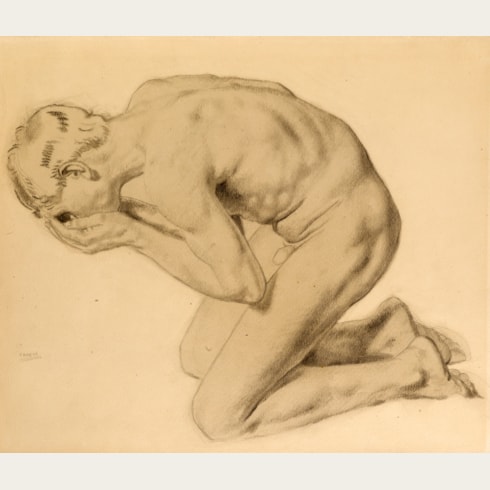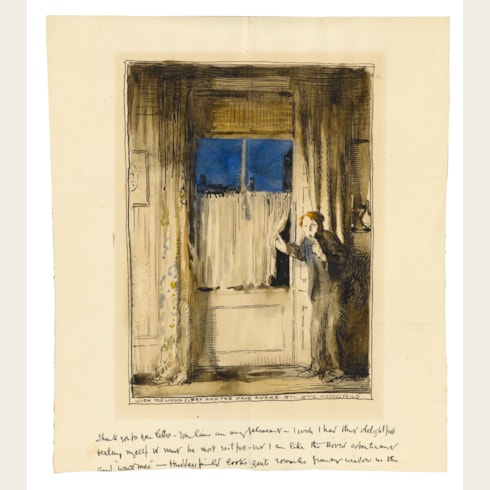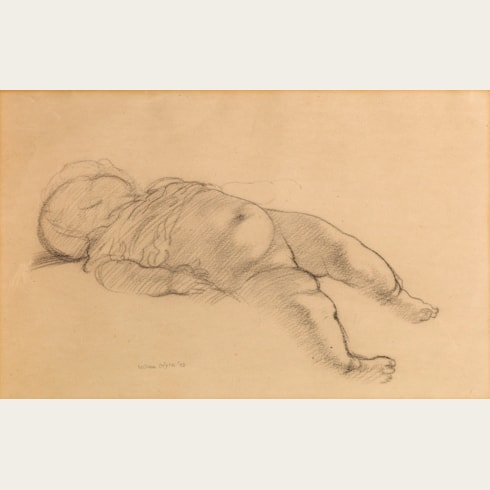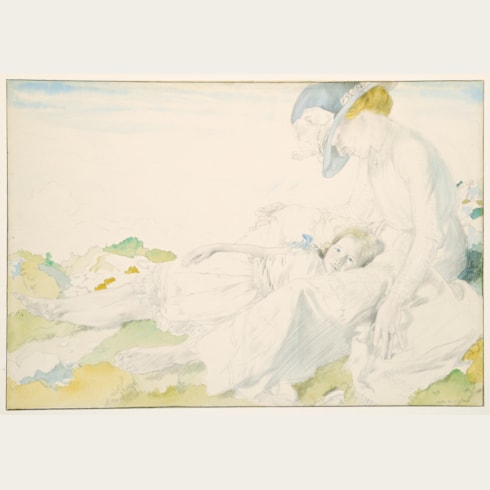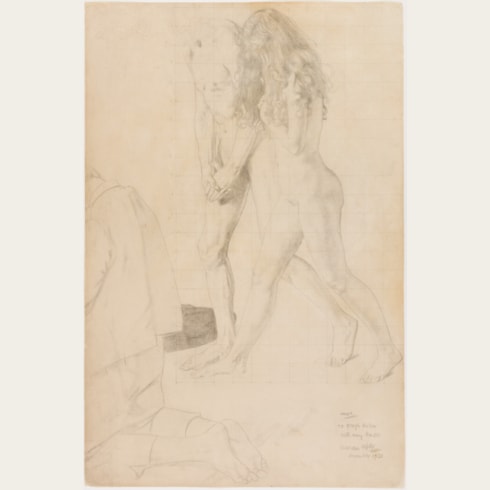William ORPEN
(Stillorgan 1878 - London 1931)
Portrait of Grace Knewstub Orpen
165 x 130 mm. (6 1/2 x 5 1/8 in.) [image]
366 x 196 mm. (14 3/8 x 7 3/4 in.) [sheet]
The present sheet is a preparatory study for Orpen’s three-quarter length double portrait of himself and Grace painted in 1901, the year of their wedding, and shown at the Society of Portrait Painters exhibition at the New Gallery in London that year. (The present whereabouts of the painting are unknown.) As Orpen’s biographer Bruce Arnold noted of the artist, ‘He painted a large canvas of himself and Grace, side by side. A study for this double portrait was included subsequently in the Carfax exhibition as No.7, ‘Two Portraits’ priced at £6, while the painting was sent in to the Society of Portrait Painters, Orpen’s first work to be exhibited with that group. It is remarkable. Orpen, even then, was a creator of fact, not of myth. It cannot be described as a happy honeymoon painting. But it is a truthful examination of himself and his wife, raw and uncompromising. The artist’s own expression is serious and intense. There is no attempt at self-caricature. Grace is painted in a stiff and slightly gauche pose, taller than he - as she was - leaning back, and with a hint of suspicion or doubt in her eyes. Her auburn hair is plainly done in a hank at the nape of her neck, and there is a reddish flush to her cheek, not altogether attractive and hinting at her rather poor health. Nevertheless, the painting’s simplicity and directness of statement are compelling, as is the richness of tone, and the firm handling of light.’
The pendant to the present sheet, a self-portrait of the artist - of identical medium, technique, dimensions and provenance, also a study for the now-lost double portrait - was recently sold at auction. It is possible that both portrait drawings once made up a single sheet, and if so may perhaps be identified with the drawing mentioned by Arnold as exhibited at the Carfax Gallery in 1901.
The present sheet belonged to the engraver and noted art collector J. P. Heseltine (1843-1929), whose collector’s mark is stamped on the verso. Over a period of fifty years, Heseltine assembled a superb collection of paintings, prints and, especially, Old Master drawings, including nine sheets by Raphael, more than seventy drawings by Rembrandt and forty by Claude. Some six hundred drawings from the Heseltine collection were acquired en bloc in October 1912, for a sum said to be £150,000, by the London art dealers P. & D. Colnaghi & Obach. The stamp found on the verso of the present sheet, however, was applied by Heseltine to those drawings which he retained, and which were not part of the 1912 sale.
This drawing is likely to have later entered the collection of the Yorkshire collector Wyndham T. Vint, who assembled a large and varied group of paintings and drawings by British artists of the 19th and 20th centuries.
William Orpen showed a talent for art at an early age, and in 1891 was admitted into the Metropolitan School of Art in Dublin. He soon came to the attention of his teachers and contemporaries as an immensely gifted draughtsman, and won several prizes for his drawings. In 1898, he transferred to the Slade School of Art in London, where his drawings continued to impress all who saw them. At the Slade, where his professors included Philip Wilson Steer and Henry Tonks, he met and befriended Augustus John. The two young artists soon came to dominate their class at the school, where they were quickly recognized as head and shoulders above their fellow students in terms of talent. Orpen joined the New English Art Club, and exhibited at the Royal Academy and the Royal Hibernian Academy. He was appointed an Official War Artist in 1917, and his powerful paintings and drawings of the trenches in France were exhibited in London the following year. Knighted in 1918, Orpen later published more of his scenes of the war in An Onlooker in France, 1917-1919, which appeared in 1921. The 1920’s found the artist at the height of his success, firmly established as one of the leading portrait painters in England, with a fashionable clientele and no shortage of commissions. Yet after his death at the age of only fifty-two his reputation lapsed into obscurity, and it has not been until relatively recently that he has regained something of the stature he once enjoyed.
Throughout his career, William Orpen was admired as one of the finest draughtsmen of his day. He drew for long hours every day, and left behind a large corpus of drawings and sketches. As the critic of The Art News commented of a publication of a portfolio of ten photogravure reproductions of his drawings in 1915, ‘These drawings are remarkable not only for their delicacy of handling, but for the loving care with which the pencil has revelled in beauty of form. Mr. William Orpen is thoroughly modern, yet he continues a tradition which has been handed down from the great draughtsmen of the past. His work does not suffer when placed by the side of the work of the Old Masters, a supreme but dangerous test.’
Another critic, writing at the same time in The Ladies’ Field, noted that ‘Mr. Orpen may be described as a tender draughtsman, tender in his care of and love for his materials. His hand is so marvellously delicate. His pencil hovers over the paper with the grace of a butterfly…He does not strive for the beauty of feature, as the French draughtsmen of the eighteenth century tried to capture those qualities. At times he is almost ugly and brutal; but he never loses the beauty of form.’
Provenance
His posthumous sale (‘The Celebrated Collection of the late J. P. Heseltine, Esq.’), London, Sotheby’s, 27-29 May 1935, part of lot 344 (‘Sir William Orpen, R.A., Portrait of the Artist, Coloured chalks, and three Others’), bt. R. E. A. Wilson for £16
R. E. A. Wilson (Savile Gallery), London
Possibly Wyndham T. Vint, Bradford, Yorkshire
Acquired by a private collector, and thence by descent.
Literature
Exhibition







